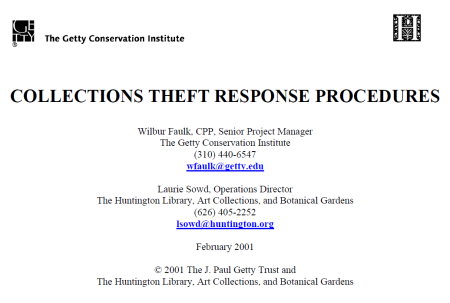Collections Theft Response Procedures

“The theft and illicit trade of cultural artifacts is a major international crime, second only to drug trade, and totaling $4 - 6 billion each year (according to the Museum Security Network). A vast majority of those thefts are committed by someone inside the cultural organization. Very few of us have any personal experience with collections theft. So, we created these Collections Theft Response Procedures to provide guidance to the multiple functions involved in theft response, and to suggest actions to take before and after the incident.
The procedures are designed for use by all cultural property organizations (museums, libraries, archives) of any size. They are not intended to be comprehensive, but to highlight issues and provide a sense of the process. Responding to a theft is like responding to a human-caused or natural disaster. The Collections Theft Response Procedures attempt to mirror the structure you may already have in place for emergency response. (See the “Agencies” page for resources on developing an emergency response plan.) They identify functions that need to be performed in responding to a theft - about 7 roles from within your organization and about 4 that are likely to be filled by people outside your institution with whom you maintain close ties. Several of these functions might be filled by one person. For each function, we have provided a checklist of activities - things to do before and after a theft. It is key to identify in advance of an incident who will be in charge, a line of succession (3 to 5 people deep) of people who are trained to perform each response function, and who will provide liaison with outside agencies. Then practice the response through drills, table-top exercises, etc.
You may need to respond to a theft in progress or to one that has been identified as occurring sometime in the past. In either case, the goal is to secure the return of the object without any injuries or damage. Recovery is greatly enhanced by quick reporting of the incident through law enforcement and other professional channels. In addition to the checklist for each function, we have provided brief guidelines on preventative measures, reporting a theft, recording information about objects, and current law. On the last page, you will find a suggestion of the primary steps to take following a theft.” (Introduction)
